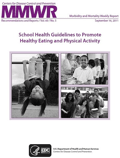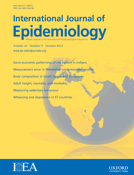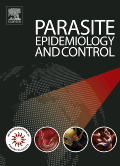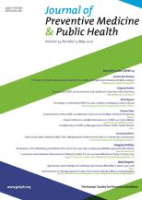
MMWR-MORBIDITY AND MORTALITY WEEKLY REPORT
Scope & Guideline
Transforming Health Insights into Action
Introduction
Aims and Scopes
- Epidemiological Surveillance and Reporting:
The journal emphasizes the importance of tracking disease outbreaks, health trends, and vaccination coverage across diverse populations, providing crucial insights into public health challenges. - Public Health Recommendations:
It offers evidence-based recommendations from health authorities, particularly the Advisory Committee on Immunization Practices (ACIP), focusing on immunization schedules, preventive measures, and treatment protocols. - Impact of Health Interventions:
The journal evaluates the effectiveness of public health interventions, such as vaccination campaigns and health policy changes, assessing their impact on disease incidence and population health. - Health Disparities and Equity:
MMWR highlights health disparities among different demographic groups, addressing issues related to social determinants of health and advocating for equitable access to healthcare services. - Emerging Health Threats:
The journal is responsive to emerging health threats, including novel pathogens and public health emergencies, providing timely updates and guidance for healthcare practitioners and policymakers.
Trending and Emerging
- COVID-19 and Its Variants:
The ongoing impact of COVID-19, including variant tracking, vaccination coverage, and public health responses, remains a central theme in MMWR publications, reflecting its significance in current public health discourse. - Vaccination Coverage and Hesitancy:
There is a heightened emphasis on vaccination coverage, particularly for COVID-19 and childhood immunizations, along with an exploration of vaccine hesitancy and strategies to improve uptake across various demographics. - Mental Health Impact of the Pandemic:
Reports addressing the mental health repercussions of the COVID-19 pandemic, including increased rates of anxiety, depression, and substance use disorders, have become more prevalent, highlighting the need for mental health interventions. - Health Equity Initiatives:
Emerging themes around health equity and addressing disparities in healthcare access and outcomes are increasingly featured, reflecting a commitment to understanding and mitigating the impacts of social determinants on health. - Infectious Disease Surveillance:
There is a growing focus on the surveillance of emerging infectious diseases, including Mpox and other zoonotic infections, as public health agencies respond to new threats and outbreaks.
Declining or Waning
- Non-communicable Disease Reporting:
There has been a noticeable decrease in the frequency of reports focusing on chronic non-communicable diseases, such as diabetes and heart disease, as the journal pivots towards addressing urgent public health crises like infectious disease outbreaks. - Environmental Health Issues:
Reports related to environmental health, including air quality and pollution-related health impacts, have been less frequently highlighted, possibly overshadowed by the pressing focus on infectious diseases and vaccination efforts. - Longitudinal Studies on Behavioral Health:
Longitudinal studies examining long-term behavioral health trends, such as substance use and mental health disorders, are observed to be less frequent, indicating a shift in focus towards immediate public health responses. - Routine Health Screenings:
Coverage of routine health screenings and preventive care metrics has decreased, as the journal has prioritized reporting on vaccination rates and infectious disease prevention in light of recent health crises.
Similar Journals

INTERNATIONAL JOURNAL OF EPIDEMIOLOGY
Connecting researchers to elevate global health understanding.INTERNATIONAL JOURNAL OF EPIDEMIOLOGY, published by Oxford University Press, is a leading peer-reviewed journal established in 1972, dedicated to advancing the field of epidemiology and its applications in medicine. With an impressive impact factor and a Q1 ranking in both Epidemiology and Miscellaneous Medicine, this journal ranks among the top-tier publications in its category, reflecting its commitment to high-quality research and scholarship. The journal serves as a vital platform for researchers, professionals, and students to share innovative findings, methodologies, and insights in epidemiological science, thus contributing to the broader understanding of public health. The journal includes a diverse range of articles encompassing the latest trends and developments in the field, ensuring comprehensive access to essential information and promoting evidence-based practices. For those seeking rigorous academic discourse and the latest research, the INTERNATIONAL JOURNAL OF EPIDEMIOLOGY is an indispensable resource in the realm of health studies.

Indian Journal of Public Health
Advancing public health knowledge for a healthier tomorrow.Indian Journal of Public Health, published by Wolters Kluwer Medknow Publications, serves as a pivotal resource in the fields of public health, epidemiology, and health policy. With a history spanning over six decades, since its inception in 1961, this esteemed journal offers significant insights into various health-related issues affecting the Indian population and beyond. As an Open Access journal since 2010, it ensures that crucial research findings are accessible to a global audience, promoting collaboration and knowledge sharing among researchers, professionals, and students. The journal currently holds a respectable status with a 2023 ranking in the Q3 category in epidemiology, health policy, medicine (miscellaneous), and public health, environmental and occupational health, placing it among the noteworthy publications in its field. With impressive Scopus rankings and an aim to drive public health discourse, the Indian Journal of Public Health is an essential platform for those dedicated to advancing public health practices and policies.

Central European Journal of Public Health
Advancing Knowledge for Effective Health InterventionsThe Central European Journal of Public Health, ISSN 1210-7778 and E-ISSN 1803-1048, is a vital academic forum published by the NATIONAL INSTITUTE OF PUBLIC HEALTH, Czech Republic. With its comprehensive coverage of contemporary issues in public health and medicine since its inception in 1993, this journal aims to bridge the gap between research and practice, fostering a deeper understanding of health dynamics within Central Europe and beyond. As a Q3 ranked journal in both the fields of Medicine (miscellaneous) and Public Health, Environmental and Occupational Health as per 2023 metrics, it provides an accessible platform for innovative studies, policy analyses, and reviews that contribute to the global discourse on public health challenges. Though primarily based in the Czech Republic, it welcomes contributions from a worldwide audience, enhancing its scope and impact. Researchers, practitioners, and students will find invaluable insights that not only enrich academic scholarship but also inform effective public health interventions.

Parasite Epidemiology and Control
Advancing knowledge to combat parasitic threats.Parasite Epidemiology and Control is a premier open-access journal published by Elsevier, dedicated to advancing the understanding of parasites and their impact on public health. Since its inception in 2016, the journal has established itself as a prominent publication in the fields of epidemiology, infectious diseases, and parasitology, achieving a commendable classification of Q2 in these categories as per 2023 metrics. With its ISSN 2405-6731, the journal serves as a vital resource for researchers, practitioners, and students, offering rigorous, peer-reviewed articles that illuminate parasite-related epidemiological trends and control strategies. Based in the United Kingdom, Parasite Epidemiology and Control actively promotes open access, ensuring that crucial research findings are readily accessible to a global audience, thus enhancing collaborative efforts in tackling parasitic diseases. The journal's impact is reflected in its Scopus rankings—ranking 17th in Parasitology among 79 journals, 47th in Epidemiology among 148, and 121st in Infectious Diseases among 344—underlining its significance in the scientific community. Join us in exploring this critical field and contributing to the fight against parasitic diseases through innovative research and shared knowledge.

Romanian Journal of Military Medicine
Pioneering insights in the realm of military medicine.The Romanian Journal of Military Medicine, with ISSN 1222-5126 and E-ISSN 2501-2312, is a premier publication dedicated to advancing the field of military medicine. Published by the esteemed Carol Davila University of Medicine & Pharmacy, this Open Access journal has been serving the global medical community since 2014, ensuring that vital research and advancements are accessible to all. Located in Bucharest, Romania, the journal provides a critical platform for researchers, healthcare professionals, and students to share innovative studies and practices pertaining to military health, trauma care, and related disciplines. Emphasizing the importance of evidence-based approaches in military contexts, the Romanian Journal of Military Medicine invites contributions that address contemporary challenges and solutions within the sphere of military healthcare, ultimately fostering collaboration and knowledge sharing across borders.

Lancet Regional Health - Southeast Asia
Advancing Health Solutions for Southeast AsiaLancet Regional Health - Southeast Asia, published by ELSEVIER, stands as a pivotal open-access journal established in 2022, dedicated to advancing regional health discourse across Southeast Asia. With its ISSN 2772-3682, this journal endeavors to provide a platform for high-quality research and innovative solutions in key areas such as Infectious Diseases, Psychiatry and Mental Health, and Public Health, Environmental and Occupational Health. Recognized for its exceptional quality, it has achieved Q1 rankings in these pressing categories, reflecting its commitment to publishing impactful findings that resonate with both the academic community and practitioners alike. The journal is vowed to fostering open access, enhancing the reach and applicability of its content to aid policy-making and community health advancements in the region. By facilitating access to groundbreaking research, Lancet Regional Health - Southeast Asia plays an essential role in shaping public health narratives and promoting collaboration among researchers, students, and healthcare professionals.

Sante Publique
Empowering professionals through vital health research.Sante Publique is a distinguished journal in the field of public health, providing a vital platform for research and discourse on contemporary health issues. Published by the Société Française de Santé Publique, this French journal has been pivotal since its inception in 1947, showcasing significant contributions to understanding and addressing the complexities of health within populations. Although categorized in Q4 of the Public Health, Environmental and Occupational Health quartile rankings for 2023, it remains an important resource for emerging research and discussions in the public health arena. Researchers and professionals benefit from its rich historical context and its commitment to promoting knowledge and innovation in health practice. With a focus on facilitating academic and practical dialogue, Sante Publique stands as a crucial reference point for those dedicated to improving health outcomes in France and beyond, despite its current positioning in the Scopus rankings. Access options may vary, requiring interested readers to check the journal’s official website for the newest updates. For those passionate about public health, Sante Publique serves as both a source of knowledge and a conduit for impactful public health solutions.

Journal of Preventive Medicine & Public Health
Elevating public health through impactful research.Journal of Preventive Medicine & Public Health is a premier peer-reviewed open-access journal published by the Korean Society for Preventive Medicine, dedicated to advancing the fields of preventive medicine and public health. Established in 1968, this journal has carved out a significant niche in the academic community, reflected in its prestigious Q1 ranking in both Medicine (miscellaneous) and Public Health, Environmental, and Occupational Health as of 2023. With a focus on disseminating high-quality research, the journal serves as an essential platform for researchers, professionals, and students to share innovative findings and discuss contemporary challenges in health prevention strategies. The journal maintains a strong commitment to accessibility, offering open access to its content since inception, ensuring that critical research is readily available to the global community. The Journal of Preventive Medicine & Public Health not only contributes to the scientific discourse but also plays a pivotal role in shaping public health policies, making it an invaluable resource for anyone invested in the health sciences.

Sudan Journal of Medical Sciences
Exploring groundbreaking research in diverse medical disciplines.Sudan Journal of Medical Sciences is an esteemed open-access publication dedicated to advancing the field of medicine, published by KNOWLEDGE E since 2006. Based in the vibrant United Arab Emirates, this journal provides a platform for researchers, professionals, and students to share innovative research findings and critical reviews across various medical disciplines. With an E-ISSN of 1858-5051, it is recognized for its contribution to the scientific community, albeit currently categorized in the Q4 quartile for Medicine (miscellaneous) and ranked #604 in the General Medicine category by Scopus. The journal focuses on disseminating knowledge and fostering collaboration among medical professionals, thereby enhancing the understanding of contemporary health challenges. As it converges its focus from 2022 to 2024, the Sudan Journal of Medical Sciences aims to provide high-quality research outputs that address pressing medical issues, thereby encouraging an informed discourse in the medical field.

Advances in Public Health
Empowering global health with groundbreaking insights.Advances in Public Health is a distinguished open access journal dedicated to the dissemination of cutting-edge research in the field of public health, published by HINDAWI LTD. Since its inception in 2014, this journal has aimed to foster innovation and facilitate critical discourse on public health challenges, policies, and practices across the globe. With an ISSN of 2356-6868 and an E-ISSN of 2314-7784, it maintains a robust presence in the academic community, featuring prominently with a Scopus rank of #213/665 and proudly residing in the Q2 category within Public Health, Environmental, and Occupational Health as of 2023. Based in Egypt, and serving an international readership, Advances in Public Health provides a platform for researchers, professionals, and students to share their findings and insights, ultimately contributing to the improvement of health outcomes worldwide. Its open access format ensures that valuable research is available to a broader audience, promoting collaboration and knowledge sharing within the public health domain.